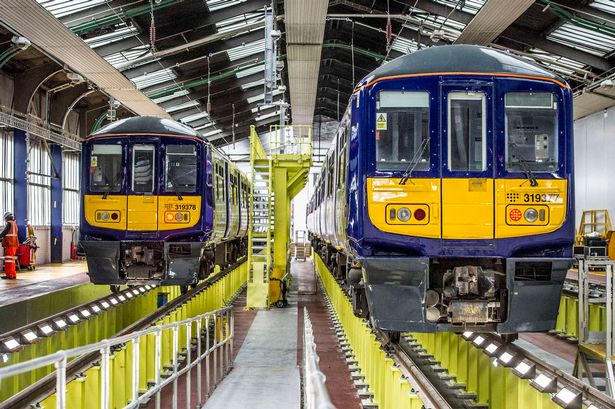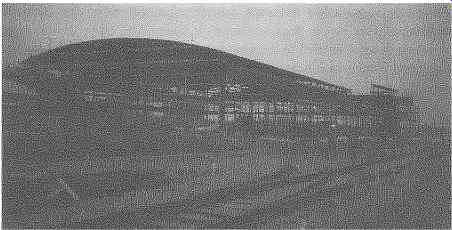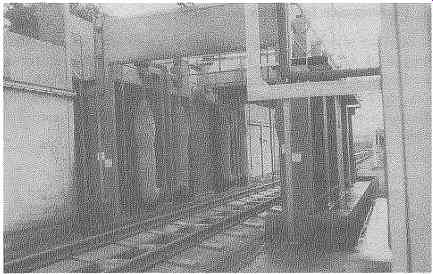1. Proper maintenance of rolling stock
Any railroad relies upon proper maintenance of both its rolling stock and its infrastructure to ensure that efficient and reliable operation is sustained.
Both operational and maintenance considerations need to be fully taken into account at the planning stage and should be monitored in the first years of operation to check that assumptions were correct and procedures are adequate. Failure to do this could result in a steadily declining standard of satisfaction.
Designers and engineers must discipline themselves to revisit installations or systems to see for themselves how things have actually worked out in practice.
This is common sense but the need do this cannot be over stressed and applies to all disciplines. The author has visited many railroad systems around the world and could cite examples where consultants have repeated mistakes on new railroads simply because they did not check experience gained on other similar installations. Similarly, all those engaged in design in any field need to consult and draw on the 'real life' experience of manufacturers, operators and maintainers.
There are many examples of this but just one is given. Deficient sliding door gear is one of the most frequent reasons for taking rapid transit stock out of service. Designers need to understand in this area for instance what usually causes the failures and how often they occur, how passengers' action contributes to the failures, what the operators have to do to rectify matters in the immediate term and how quickly faults can be rectified.
Apart from the obvious economic considerations, lack or deterioration of adequate maintenance of rolling stock will have a progressively adverse effect on the following:
- Safety
- Customer satisfaction and co-operation
- Customer perception of reliability
- Availability - this will influence the total number of trains that are necessary in the fleet for a given level of service
- Morale and 'pride' of operating staff
2. Rolling stock maintenance considerations
Generally speaking, maintenance of rolling stock can be divided into two main categories, planned and unplanned or more usually known as routine and casualty. In the area of planned routine maintenance activity the following can be included:
- Preparation for service
- Routine examination
- Cleaning
- Renewal of consumables (SUL as brake pads, light bulbs, upholstery cushions etc)
- unit exchange
- major mechanical overhaul
In the routine completion of all these activities, operators and engineers need to co-operate to establish the best layout, sequence of events and frequency for every activity involved.
3. Establishing a maintenance regime
Every railroad needs to establish for itself a regime for the regular maintenance of rolling stock. The various activities, involving both inspection and work to components, will necessitate some time when stock is not available for normal operation. It is difficult to get the balance right between over and under maintenance and this must be watched carefully, allowing suitable adjustments to be made in both procedures and frequencies when these are shown to be necessary.
With a new railroad, or with entirely new stock on an existing railroad, the following factors should be taken into consideration when establishing a maintenance regime initially:
experience with similar stock on other railroads;
manufacturers recommendations;
theoretical wear and fatigue deterioration of replaceable components e.g., brake linings etc;
climatic conditions i.e., extremes of heat, cold, or wet;
degree of heavy use e.g., extreme crowding of passengers or carriage of very heavy and abrasive materials;
required comfort/cleanliness standards for passengers concerned e.g., First Class overnight long distance travelers would expect a higher standard than short distance suburban Standard Class commuters.
It is essential that all those involved in maintenance are provided with reliable and up to date information. Staff need to be adequately trained and be provided with the necessary maintenance manuals. Of equal importance is the necessity to keep accurate up to date records of every maintenance activity on each item of rolling stock so that the history of each vehicle is properly documented. In the past this activity was a laborious but necessary 'chore', but with the advent of the computer the keeping of such records should be much easier.
4. Maintenance management
Having established a maintenance regime each railroad system will need to set up an organization for adequately managing the maintenance process and monitoring it. Up until very recent years it has been traditional on most railroads to maintain rolling stock 'in-house'. This involved extensive workshops and proportionately large labor forces but it did have the effect of keeping control within the parent organization. In this case however, the size of the workforce and the workshop plant and facilities needs to carefully match the actual demand or it will be inadequate if too small or unduly costly if too extensive. Manpower can be adjusted if demand changes but it is not always possible to modify plant and buildings once they have been installed.
In recent years, much more thought has been given to contracting out certain maintenance operations. This is more flexible if demand changes but does require more control. Many components and units are now made for easy replacement. The replacement of the units can be done in the railroad's own workshops or depots leaving the manufacturers to service or repair their own units and components on a contractual basis. Because of this trend, many railroad workshops have either closed or become very much reduced in size.
5. The balance between workshops and depots
Originally railroad companies set up both railroad workshops and railroad depots on their systems. As practically all the engineering work was done
'in-house', the scope of activities was very wide and depots and workshops had very differing functions.
In many cases, the early railroad companies manufactured their own locomotives and rolling stock and carried out all major repairs and refitting in the same works. The practice has gradually changed over the years and now most manufacture and major overhaul is carried out by independent suppliers.
Railroads therefore need to carefully consider what engineering activities still need to be carried out on their own premises and by their own staff.
Having decided this, it is a short step to a decision as to what operations are most sensibly carried out at a depot and which are better done at a separate workshop location.
On many railroads, depots contain a minimum of workshop facilities for day-to-day maintenance and unit/component changing, the major work being carried out elsewhere by tendered contract, either by supplier or 'in-house'.

FIG. 1. Diesel-electric maintenance depot.
6. Depot siting
The siting of depots on any railroad system is important and needs to be given careful consideration in the planning stage.
Main line railroad operating patterns usually require depots to be as close as possible to termini or to origin/destination points for freight running.
There will often be severe constraints at such locations relating to space availability and high land costs. Even so, final locations should be not too far away from the ideal siting as 'empty running' costs and times will amount to a considerable sum over a depot lifetime.
Some reduction of these costs can sometimes be effected by stabling trains in sidings or even station platforms closer to the point of operational origin than depots. However this can have disadvantages in that rolling stock will not have full depot facilities available should cleaning, minor overnight servicing or repairs be necessary.
Metros and light railroads which serve a city or large conurbation will often have lines or services which originate in outer suburbs, run through the city center and out to suburbs on the other side, with some converging or at least interchange with other lines or transport modes.
At the beginning and end of the traffic day on such systems traffic demand will fall off, particularly in the outer areas. Because of this some trains will often be reversed before they reach the outer termini, reducing the train frequency in the outer suburbs. This likely pattern of operation needs to be carefully considered before location of depots is finalized on Metros, light railroads and other essentially suburban commuter services.

FIG. 2. Typical Metro Depot for London Underground.
For Metros therefore the most practical location for a depot is often about half to three quarters of the distance out from the city center. At this point land will be more available, but not too far out for easy access for operating and engineering staff.
At this location, it is also more likely that the potential problems of lack of space, noise, pollution and proximity of neighbors can be overcome.
Another advantage of such a location is that the depot can be double ended. This means that entry and exit to the depot for trains leaving or entering service can be in either direction and at either end. Experience has shown that if a depot has just one point of entry from the running lines, extensive delays and disruption can be caused by just one train becoming immobilized or one set of points failing at the depot entrance. In bad weather also frozen points at one end can completely shut up all the trains in a depot at the commencement of a traffic day.

FIG. 3. DLR depot during construction.
7. The needs of the maintainer
Maintenance requirements need to be carefully considered by the designer of rolling stock. All too often stock is designed without any proper appreciation of the needs of the maintainer.
As a guide, the following twelve key requirements must be kept in mind:
- Good access to components
- No dust or dirt traps
- Simple fault finding systems
- No superfluous equipment
- High reliability, proven equipment
- Minimum number of quick release fastenings
- Easily removable sub-assemblies
- Small number of tools required
- Simple isolation of systems
- All fixings capable of torque tightening
- Equipment cases watertight
- Maximum interchangeability of components
As can be seen, a few moments consideration will show that all these requirements are simply 'common sense'. It is surprising however how often maintainers are thwarted in carrying out simple operations because one of these considerations has been overlooked.
8. Basic requirements for depots
Each railroad must carefully look at the different functions that need to be carried out within the depot. The size of the fleet, diversity of stock type and turn-around of trains will all have a bearing on the facilities required.
The following twelve basic general requirements need to be addressed:
- Sidings which are adequate to stable the maximum number of trains/ units likely to be in the depot, with adequate access walkways for operating and engineering staff.
- Adequate provision of point and crossing work and 'shunt necks' to enable trains to be moved within the depot to allow proper cleaning and maintenance and marshalling in correct order for service. The layout should preferably be 'double ended'. Some form of control of points and train movements in the depot needs to be provided.
- Covered workshops with all necessary cranes/jacks, inspection pits, walkways, equipment, test facilities and etc for maintenance work and lifting. Road access needs to be provided to the workshop area adequate to handle the largest components that will need to be taken away for major overhaul or replacement.
- Adequate lighting and heating as appropriate.
- Staff facilities, offices and training rooms.
- Stores with both road and rail access.
- Wheel turning facility.
- Raised bogie roads and bogie wash.
- Repair facility for painted surfaces.
- Train washing arrangements for both internal and external surfaces and under-frames. Specially constructed wash roads are necessary to enable used water to be properly collected, filtered and channeled away to drains.
- De-icing arrangements.
- Fire alarms and protection.

FIG. 4. Train washing machine.
In applying these requirements to any railroad system it is advisable to remember that as well as the normal planned and predictable maintenance items of work, there will always also be unforeseen emergency items which will demand urgent work from time to time. If there is no spare capacity in depots, such incidents could cause major disruption to regular maintenance work.
Collision damage may occur from time to time. Also a small amount of local damage might occur to a large number of trains originating from a track or structure irregularity. A good example of this would be damage to wheels through sliding on wet leaves or damage to collector gear due to a displaced current rail ramp or walkway board.
On electrified railroads, there may well be other specialized requirements that will need to be provided in railroad depots. This will probably include inspection and maintenance of current collection equipment and possibly battery charging and storing.
9. Performance indicators and audit
It is necessary to establish reliable performance indicators for all classes of rolling stock to ensure that engineers and operators can detect any deterioration in maintenance standards. There must be a continuous search for the optimum maintenance regime that will give the most economic performance overall. It is also essential that a periodic audit is carried out to check independently that standards are being maintained.
Prev. | Next
Top of Page | Article
Index